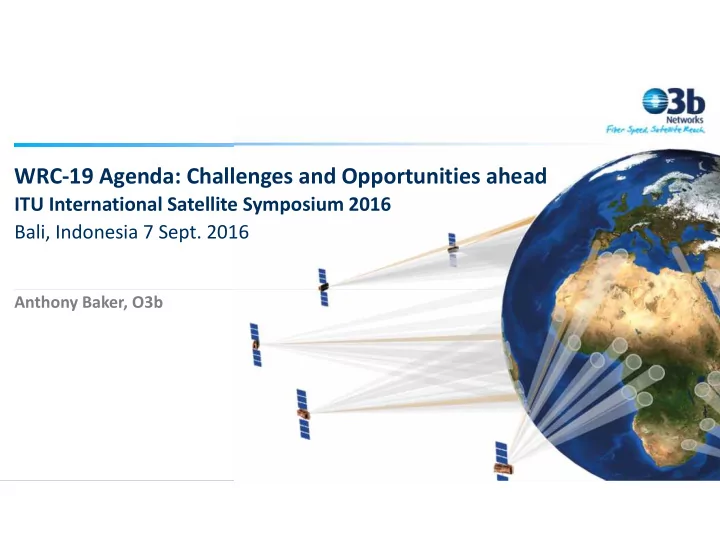

WRC-19 Agenda: Challenges and Opportunities ahead ITU International Satellite Symposium 2016 Bali, Indonesia 7 Sept. 2016 Anthony Baker, O3b
WRC-19 Issues AGENDA 1. O3b – one year on 2. AI 1.6: Regulatory framework for non-GSO FSS satellite systems in V band NGSO-NGSO/GSO coordination 3. AI 9.1.3: NGSO systems in C Band 4. Bringing into use
O3b – One Year On Fiber without the Cable 3
AI 9.1.3: NGSO systems in C Band Background •Some Administrations are seeking to revisit EPFD limits in C- band in the bands 3700-4200 MHz, 5925-6425 MHz, and 6725-7025 MHz and NGSO pfd limits in 3700-4200 MHz • Resolution 157 [COM5/6] calls to study technical and operational issues and regulatory provisions for these NGSO systems •Studies to ensure that adequate protection is assured for GSO systems in these bands 4
5
AI 1.6: Regulatory framework for non-GSO FSS satellite systems in V band • FSS V-bands of 37.5-42.5 GHz (s-to-E) and 47.2-48.9 GHz (limited to feeder links only), 48.9-50.2 GHz and 50.4- 51.4 GHz (all E-to-s) • Purpose is to develop new technologies above 30 GHz associated with both GSO and NGSO satellite constellations to provide high-capacity and low-cost means of communication even to the most isolated regions • To conduct technical/regulatory studies for the operation of NGSO FSS while: • ensuring protection of GSO satellite networks in the FSS, MSS and BSS • not limiting/unduly constraining future GSO networks • not modifying the provisions of Article 21 • Develop equivalent power flux-density limits for NGSO FSS towards GSO or into any geostationary FSS earth station • Develop sharing conditions between NGSO FSS • WP4A leading discussion 6
V-Band Challenges • Few deployed systems • Effects of rain fade (20-30 dB) - modelling propagation loss accurately is important - Fading of the wanted and interfering signals due to rain loss - Variation in transmit power of wanted and interfering signals due to power control adjusting to rain loss - Correlation between propagation loss between wanted and interfering paths 7
PrestaBist Telecoms, Chad It’s now a reality! 8
AI 7 Satellite issues The standing agenda item at all conferences to address satellite issues 1. The ITU verification software to check NGSO compliance with RRs • The beam pointing strategies and control of interference to the GSO are not possible to model • We are addressing this in the ITU-R working group 4A • The WRC-15 recognised this and noted such in the minutes of the Plenary 2. Bringing Into Use of NGSO networks • The current proposal is that 1 or 2 satellites BIU a constellation of thousands of satellites • Open to abuse • RRB considering Deployment Plan requirement • Minimum number of satellites to be define for intended service: Need for new service definitions? • WP4A should further study and new regulations enacted at WRC-19 9
Recommend
More recommend